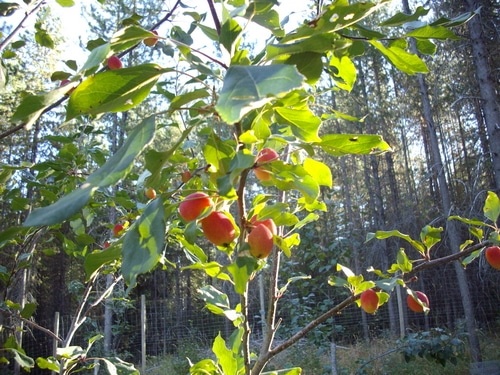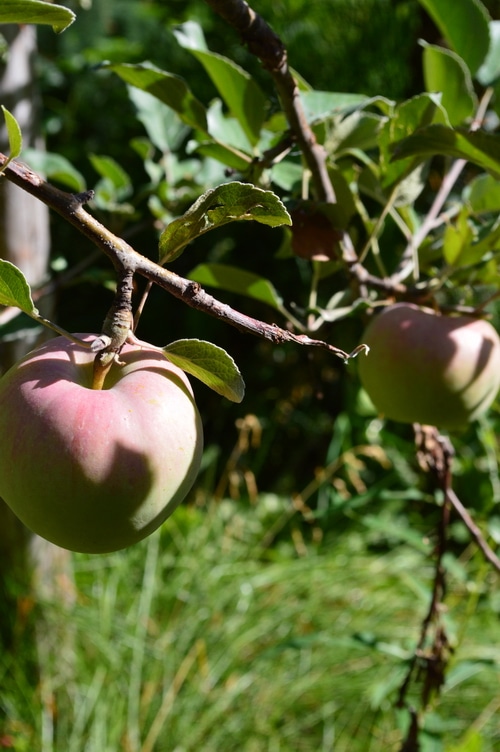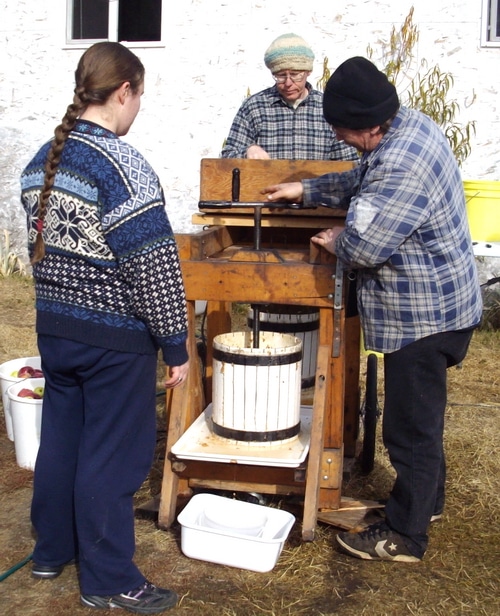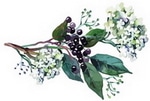Healthy apple recipes will help you make the most of the fall apple harvest so that you can be sure to get your apple a day. Be sure to include the apple peels so that you can get all the health benefits, fiber, and vitamins from the apple peel too. You can benefit from apples year round, just from your local apple harvest.
Apple season is an extended season in the northern parts of North America and Europe. The apple harvest begins with Transparent apples in July and August and extends into November with Northern Spy, Granny Smith, and other later apples. The later apples are the best apples for winter storage, root cellaring, or cold storage. This is good news for health conscious folks because apples boast one of the highest antioxidant fruits available year round. While pomegranates, cranberries, and blueberries have a reputation for being high in anthocyanins and other flavonoids, the apple can hold its own when compared to peaches, plums, nectarines, pears, and grapes for total antioxidant content.
How healthy are apples?
Apples have more antioxidants than citrus fruit, too, making them a good choice for backyard fruit in colder regions. There are apples that are hardy from zone 2 to zone 9. There are even heat tolerant apples that can grow in zone 10, although most varieties of apple trees need a short chill period to produce blossoms.
A dwarf apple tree will yield 50 to 200 pounds of apples each season. While a semi-dwarf apple tree will yield 250 to 500 pounds. If you have your own apple trees you are looking at a significant harvest. If you don’t have your own trees there may be someone in your community that will let you pick their trees in exchange for half the fruit. In many communities there are gleaners programs that allow those without land to harvest neglected fruit while offering some of it back for low income families.

But even if you have to buy your apples at the grocery store or the farmer’s market apples are a good nutritional investment. You’ve heard the adage, “an apple a day keeps the doctor away”. It turns out that there is a scientific basis for this old wives’ chant. Apples are one of the best antioxidant fruits available. They are rich in anthocyanins and other flavonoids which support the body’s own defenses against heart disease, cancers of all types, diabetes, and obesity. Of course, apples are also rich in vitamins, fiber, and provide a general boost too.

Sweet 16 on hardy Russian root stock. Very complex and sweet flavour.
Many studies have linked the consumption of apples with lower risk of mortality. Several studies have specifically linked apple consumption with a reduced risk for cancer, especially lung cancer. Another study found that women who ate 1 apple a day had a 35% decrease in risk for heart disease and stroke. It is the flavonoids in apples that are attributed with this benefit. The catechins in apples seem to be more bioavailable than catechins in tea, red wine, and other sources. In another study eating at least 2 apples or pears a week decreased the risk of asthma and lung disease in both men and women. In another study eating apples or pears 3 times a day contributed to weightloss and a reduction in blood sugar levels in overweight, middle aged women.
What difference do antioxidants make?
A single apple has the same antioxidant activity as taking a 1500 mg vitamin C supplement. However, vitamin C accounts for only .4% of the antioxidant activity in apples. The antioxidants in apples are highest in the peel, so eating unpeeled apples and using unpeeled apples for cooking will increase the health benefits of apples. Red and striped apples have more antioxidants than yellow apples and green apples. But all colors of apples have more antioxidants than many other fruit and vegetables. Apples in cold storage have very little loss in antioxidants even after being stored for a 52 weeks in cold storage. So fresh apples are a good choice year round.

Apple cider can be made on your homestead from cull apples, windfall apples, and smaller apples. From the raw cider you can make Apple Cider Vinegar at home.
When apples are juiced for cider, 60% of the antioxidants remains with the apple pomace, a waste product of the cider making. When apples are peeled for making apple sauce and apple pie filling, many of the antioxidants remain with the peel. However, these antioxidants can be salvaged if the apple peels are dried in a dehydrator and then powdered to be used as a food supplement. The antioxidants in dried apple peels are actually higher than in the fresh peel.

How to maximize the health benefits of the apple harvest
- Eat apples every day and at least twice a week
- Eat the apple peel with the apple
- Eat apples year round (preserve them for winter)
- If you peel an apple for apple sauce or apple pie, save the peel and dry it for later use
25 apple recipes that aren’t applesauce

Apple recipes for snacks
Fresh apples are great for snacks, just on their own. Simply wash and slice an apple, then pair it with your favorite dip. Apples dipped in honey actually make a great fresh apple dessert, without the need to use an oven. Pink Lady apples are a great, crisp apple for snacking.
- Fresh apple slices dipped in honey
- Apples with caramel sauce is an awesome addition to your list of after school autumn treats.
- Apple slices with peanut butter, or other nut butter.
- Apple slices with cheddar cheese (like grandpa used to eat), or a nice feta. Salt actually goes well with the apple’s sweetness.
- Honey caramel apples
- Apple sauce has a natural sweetness, and doesn’t need additional sugar. Make apple sauce to your own taste preference.
- Dried apple slices (leave the skin on when you dry them)
- Apple cookies
- Fruit leather
Apple recipes for dinner
Apples work well with many savory flavors. Surprisingly even cinnamon can work well with savory dishes.
- Apple and onion sauté
- Green apple slices in spring greens salad
- Grated apple into coleslaw salad
- Add apple pieces to Kale Salad
- Baked apples and onions with roast chicken, beef, or pork.
- Apple and Squash stuffing for turkey, or as a stove top style stuffing dish that is gluten free.
- Bake apples and butternut squash or pumpkin together topped with brown sugar, maple syrup, or honey.
Apple recipes for Desserts
Classic apple deserts may be the most familiar way you’ve eaten apples. Serve most apple desserts with a scoop of vanilla ice cream, or whipping cream, if desired. Tweak the ingredients to what you enjoy, and to any allergies in your own house. Apple goes well with oatmeal, walnuts, oats, and more.
- A classic Apple pie, or add caramel to make a caramel apple pie. Use butter for a nice buttery crust, avoid vegetable shortening when possible.
- Apple Crisp, this makes well out of tart granny smith apples, if you prefer a less sweet dessert.
- Apple Betty
- Apple Cake, A nice apple cake can be made in one bowl. Make a cream cheese frosting to impress guests with your secret apple dessert.
- Apple spice bundt cake
- Apple molasses cake
- Apple muffins are always a great way to use the orchard abundance.
Best Apple Recipes for Condiments
Surprisingly apples can go well in condiments, and pair well with many other dishes. Make apple and maple apple butter to go with pork chops, turkey, or even baste chicken thighs. Or try some of the other recipes and experiment.
- Apple cider vinegar
- Apple salsa verde
- Maple apple butter
- Apple ketchup
- Apple mustard sauce, the mustard adds a nice bite to the sweetness of the fruit.
Many apple recipes will be just as flavorful if you leave the peels on the apples when you prepare them for the recipe. Organically grown apples have thin peels that are not unsightly in apple pies, apple crumbles, or even in apple sauce. By leaving the peels on organically grown apples you will increase the health benefits of your apple a day. However, apples are one of the dirty dozen, so if you aren’t buying organic apples, be sure to wash them well in a vinegar/dish soap rinse to remove pesticide residues before you eat them or process them.





If you have a large stock pot or any pot that can hold enough water so that it comes over the top of the jars by at least 1 inch, that will work. There are inserts you can purchase that will hold the jars off the bottom of the pot (essential to prevent breakage) I’ve used canning jar rings turned upside down in the pot, in a pinch. Placing the canning jars into the rings to hold them up off the bottom of the pot.
Is there a way to do this without a special canning pot?
I’m not sure how often I will do this, so I don’t want to invest in an extra/expensive pot until I know